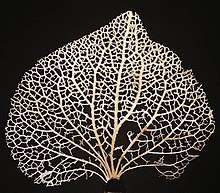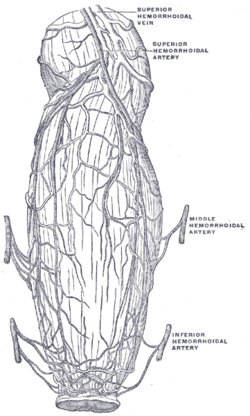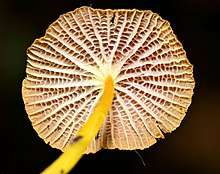Anastomosis
An anastomosis (plural anastomoses) is a connection or opening between two things (especially cavities or passages) that are normally diverging or branching, such as between blood vessels, leaf veins, or streams. Such a connection may be normal (such as the foramen ovale in a fetus's heart) or abnormal (such as the patent foramen ovale in an adult's heart); it may be acquired (such as an arteriovenous fistula) or innate (such as the arteriovenous shunt of a metarteriole); and it may be natural (such as the aforementioned examples) or artificial (such as a surgical anastomosis). The reestablishment of an anastomosis that had become blocked is called a reanastomosis. Anastomoses that are abnormal, whether congenital or acquired, are often called fistulas.

The term is used in medicine, biology, mycology, geology, geography, and architecture.
Etymology
Anastomosis: medical or Modern Latin, from Greek ἀναστόμωσις, anastomosis, "outlet, opening", Gr ana- "up, on, upon", stoma "mouth", "to furnish with a mouth".[1] Thus the -stom- syllable is cognate with that of stoma in botany or stoma in medicine.
Medical anatomy

An anastomosis is the connection of two normally divergent structures.[2] It refers to connections between blood vessels or between other tubular structures such as loops of intestine.
Circulatory
In circulatory anastomoses, many arteries naturally anastomose with each other; for example, the inferior epigastric artery and superior epigastric artery, or the anterior and/or posterior communicating arteries in the Circle of Willis in the brain. The circulatory anastomosis is further divided into arterial and venous anastomosis. Arterial anastomosis includes actual arterial anastomosis (e.g., palmar arch, plantar arch) and potential arterial anastomosis (e.g. coronary arteries and cortical branch of cerebral arteries). Anastomoses also form alternative routes around capillary beds in areas that don't need a large blood supply, thus helping regulate systemic blood flow.
Surgical
An example of surgical anastomosis occurs when a segment of intestine, blood vessel, or any other structure are connected together (anastomosed). Examples include intestinal anastomosis, Roux-en-Y anastomosis or ureteroureterostomy. Surgical anastamosis techniques include Linear Stapled Anastomosis,[3] Hand Sewn Anastomosis,[3] End-to-End Anastomosis (EEA).[4] Anastomosis can be performed by hand or with an anastomosis assist device.[5] Studies have been performed comparing various anastomosis approaches taking into account surgical "time and cost, postoperative anastomotic bleeding, leakage, and stricture".[6]
Pathological
Pathological anastomosis results from trauma or disease and may involve veins, arteries, or intestines. These are usually referred to as fistulas. In the cases of veins or arteries, traumatic fistulas usually occur between artery and vein. Traumatic intestinal fistulas usually occur between two loops of intestine (entero-enteric fistula) or intestine and skin (enterocutaneous fistula). Portacaval anastomosis, by contrast, is an anastomosis between a vein of the portal circulation and a vein of the systemic circulation, which allows blood to bypass the liver in patients with portal hypertension, often resulting in hemorrhoids, esophageal varices, or caput medusae.
Biology
Evolution
In evolution, anastomosis is a recombination of evolutionary lineage. Conventional accounts of evolutionary lineage present themselves as the simple branching out of species into novel forms. Under anastomosis, species might recombine after initial branching out, such as in the case of recent research that shows that ancestral populations along human and chimpanzee lineages may have interbred after an initial branching event.[7] The concept of anastomosis also applies to the theory of symbiogenesis, in which new species emerge from the formation of novel symbiotic relationships.
Mycology
In mycology, anastomosis is the fusion between branches of the same or different hyphae.[8] Hence the bifurcating fungal hyphae can form true reticulating networks. By sharing materials in the form of dissolved ions, hormones, and nucleotides, the fungus maintains bidirectional communication with itself. The fungal network might begin from several origins; several spores (i.e. by means of conidial anastomosis tubes), several points of penetration, each a spreading circumference of absorption and assimilation. Once encountering the tip of another expanding, exploring self, the tips press against each other in pheromonal recognition or by an unknown recognition system, fusing to form a genetic singular clonal colony that can cover hectares called a genet or just microscopical areas.[9]
For fungi, anastomosis is also a component of reproduction. In some fungi, two different haploid mating types – if compatible – merge. Somatically, they form a morphologically similar mycelial wave front that continues to grow and explore. The significant difference is that each septated unit is binucleate, containing two unfused nuclei, i.e. one from each parent that eventually undergoes karyogamy and meiosis to complete the sexual cycle.
Also the term "anastomosing" is used for mushroom gills which interlink and separate to form a network.[10]

Botany
The growth of a strangler fig around a host tree, with tendrils fusing together to form a mesh, is called anastomosing.[11]
Geology
In geology, anastomosis refers to quartz (or other) veins displaying this property, which is often related to shearing in metamorphic regions.
Geography
Anastomosing streams consist of multiple channels that divide and reconnect and are separated by semi-permanent banks formed of cohesive material, such that they are unlikely to migrate from one channel position to another. They can be confused with braided rivers based on their planforms alone, but braided rivers are much shallower and more dynamic than anastomosing rivers. Some definitions require that an anastomosing river be made up of interconnected channels that enclose floodbasins,[12] again in contrast with braided rivers. Rivers with anastomosed reaches include the Magdalena River in Colombia,[13] the upper Columbia River in British Columbia, Canada,[14] and the upper Narew River in Poland.[15] The term anabranch has been used for segments of anastamosing rivers.
References
- Online Etymology Dictionary Douglas Harper
- Gylys, Barbara A.; Mary Ellen Wedding (2005), Medical Terminology Systems, F.A. Davis Company
- "Laparoscopic Anastomotic Techniques - A SAGES Wiki Article". SAGES. Retrieved 2018-06-28.
- Akelina, Yelena (2014-03-31). "Microsurgical Technique for 1mm Vessel End to End Anastomosis". Journal of Medical Insight. 2014 (3). doi:10.24296/jomi/2. ISSN 2373-6003.
- Kikuchi, Keita; Tambara, Keiichi; Yamamoto, Taira; Yamasaki, Motoshige; Hirose, Hitoshi; Amano, Atsushi (2010). "The Use of Enclose®II Anastomosis Assist Device for the Proximal Coronary Branch Anastomosis to Vascular Graft". Annals of Vascular Diseases. 3 (1): 84–86. doi:10.3400/avd.hdi08023. ISSN 1881-641X. PMC 3595814. PMID 23555395.
- Yao, Libin; Li, Chao; Zhu, Xiaocheng; Shao, Yong; Meng, Song; Shi, Linsen; Wang, Hui (2016-11-26). "An Effective New Intestinal Anastomosis Method". Medical Science Monitor. 22: 4570–4576. doi:10.12659/MSM.902000. ISSN 1234-1010. PMC 5138069. PMID 27888280.
- Patterson, Nick; et al. (May 2006). "Genetic evidence for complex speciation of humans and chimpanzees". Nature. 441 (7097): 1103–1108. Bibcode:2006Natur.441.1103P. doi:10.1038/nature04789. PMID 16710306.
- Kendrick, Bryce (2001), The Fifth Kingdom, Mycologue Publications
- Glass L.; Rasmussen C.; Roca M.G.; Read N. (2004). "Hyphal homing, fusion and mycelial interconnectedness". Trends in Microbiology. 12 (3): 135–141. doi:10.1016/j.tim.2004.01.007. PMID 15001190.
- Marcel Bon (1987). The Mushrooms and Toadstools of Britain and North-Western Europe. Hodder & Stoughton. p. 14. ISBN 978-0-340-39935-4.
- Kricher, John C. (2017). The New Neotropical Companion (Revised ed.). Princeton, NJ: Princeton University Press. p. 52. ISBN 978-1400885589. OCLC 964359395.
- Makaske, Bart (2001). "Anastomosing rivers: a review of their classification, origin and sedimentary products" (PDF). Earth-Science Reviews. 53 (3–4): 149–196. Bibcode:2001ESRv...53..149M. doi:10.1016/s0012-8252(00)00038-6. Archived from the original (PDF) on 2016-10-11. Retrieved 2016-08-21.
- Smith, D (1986). "Anastomosing river deposits, sedimentation rates and basin subsidence, Magdalena River, northwestern Colombia, South America". Sedimentary Geology. 46 (3–4): 177–196. Bibcode:1986SedG...46..177S. doi:10.1016/0037-0738(86)90058-8.
- Abbado, D., Slingerland, R.L., and Smith, N.D., 2005, The origin of anastomosis in the upper Columbia River, British Columbia, Canada: In Blum, M.D., Marriott, S., and Leclair. S. (eds.), Fluvial Sedimentology VII, Internat. Assoc. Sedim. Special Publ. 35.
- Gradzinski, R (2003). "Vegetation-controlled modern anastomosing system of the upper Narew River (NE Poland) and its sediments". Sedimentary Geology. 157 (3–4): 253–276. Bibcode:2003SedG..157..253G. doi:10.1016/S0037-0738(02)00236-1.